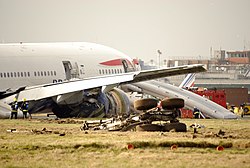Victims of London jetliner crash sue Boeing
Friday, November 20, 2009

Ten passengers on board a British Airways jet that crashed in London's Heathrow Airport are suing the manufacturer of the aircraft. Documents filed before a court in Chicago, Illinois claim that Boeing were responsible for design flaws with the fuel system.
The Boeing 777 crash-landed early in 2008 after engine power was lost on final approach, coming down short of the runway. The aircraft was severely damaged. The United Kingdom's Air Accidents Investigation Branch is still investigating, but interim reports have indicated that engine components became clogged with ice developing in the fuel.
The crew of the aircraft were praised for their handling of the emergency, avoiding the perimeter fence and nearby houses. None of the 136 passengers and 16 crew were killed but some of those suffered serious injuries, including broken bones and facial injuries. Some were left unable to fly and there were cases of Post Traumatic Stress Disorder.

The case, run by London firm Stewarts Law, is that Boeing are liable for the design of the engine component upon which the ice settled during the accident. "Our clients are not critical of BA and feel that the pilots performed heroically in guiding the aircraft down in exceptionally difficult circumstances," said the partner in charge of the case, Stuart Dench. "However the two interim reports from the Air Accident Investigation Branch suggest design defects in the aircraft's fuel system and in particular its limitations in the prevention of dangerous ice build-up. The passengers we represent are therefore prepared to take on Boeing in its home court in Chicago, which is undoubtedly the most appropriate jurisdiction for this case."
Boeing may seek to have the case heard in London before the High Court. If successful, the claimants are estimated by the media to be able to claim US$1 million (£600,000).
Sources
- Martin Beckford. "Heathrow plane crash survivors fight for £1million damages from Boeing in landmark case" — The Telegraph, November 19, 2009
- "Crash-land passengers to sue Boeing" — The Press Association, November 19, 2009
